Principles and Standard Conditions for Different Purification Techniques
Affinity Chromatography (AC)
AC media separate proteins on the basis of a reversible interaction between a protein (or a group of proteins) and a specific ligand attached to a chromatographic matrix. The technique is well-suited for a capture or as an intermediate purification step and can be used whenever a suitable ligand is available for the protein(s) of interest. AC offers high selectivity and usually high capacity. It is frequently used as the first step (capture step) of a two-step purification protocol, followed by a second chromatographic step (polishing step) to remove remaining impurities.
The target protein(s) is/are specifically and reversibly bound by a complementary binding substance (ligand). The sample is applied under conditions that favor specific binding to the ligand. Unbound material is washed away, and bound target protein is recovered by changing conditions to those favoring elution. Elution is performed specifically, using a competitive ligand, or nonspecifically, by changing the pH, ionic strength, or polarity. Samples are concentrated during binding, and the target protein is collected in purified and concentrated form. The key stages in an AC separation are shown in Figure A11.1. AC is also used to remove specific contaminants; for example, Benzamidine Sepharose 4 Fast Flow (high sub) removes serine proteases.
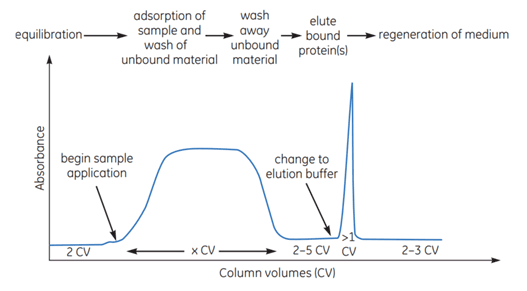
Figure A11.1.Typical affinity purification
Ion Exchange Chromatography (IEX)
IEX media separate proteins based on differences in surface charge, generating high-resolution separations with high sample loading capacity. The separation is based on the reversible interaction between a charged protein and an oppositely charged chromatography medium. Proteins bind as they are loaded onto a column. Conditions are then altered so that bound substances are eluted differentially. Elution is usually performed by increasing salt concentration or changing pH. Changes are made stepwise or with a continuous linear gradient. Most commonly, samples are eluted with salt (NaCl), using a gradient elution (Figure A11.2). Target proteins are concentrated during binding and collected in a purified, concentrated form.
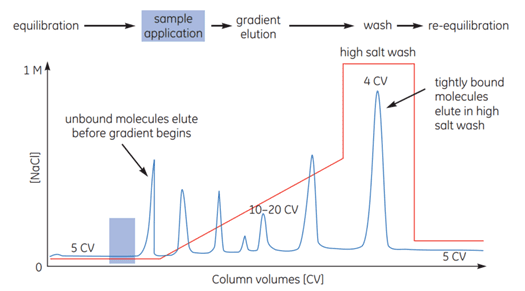
Figure A11.2. Typical IEX gradient elution. Blue line = absorbance; red line = conductivity (salt concentration).
The net surface charge of proteins varies according to the surrounding pH. Typically, when above its isoelectric point (pI) a protein will bind to an anion exchanger (e.g., Q Sepharose); when below its pI a protein will bind to a cation exchanger (e.g., SP Sepharose). However, it should be noted that binding depends on charge and that surface charges may thus be sufficient for binding even on the other side of the pI. Typically IEX is used to bind the target molecule, but it can also be used to bind impurities if required. IEX can be repeated at different pH values to separate several proteins that have distinctly different charge properties, as shown in Figure A11.3.
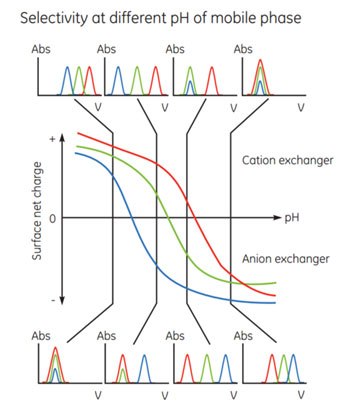
Figure A11.3. Effect of pH on protein elution patterns. V = volume.
Method development (in priority order)
- Select optimal ion exchanger using small 1 mL columns as in the HiTrap® IEX Selection Kit or HiTrap® Capto IEX Selection Kit to save time and sample. If a longer packed bed is required use prepacked HiScreen IEX columns. (HiTrap® columns have a 2.5 cm bed height, and HiScreen columns have a 10 cm bed height).
- Scout for optimal pH to maximize capacity and resolution. Begin 0.5 to 1 pH unit away from the isoelectric point of the target protein if known. This optimization step can be combined with optimizing the ionic strength of the sample and binding buffer.
- Select the steepest gradient to give acceptable resolution at the selected pH. Usually start with a 10 to 20 column volume linear gradient.
- Select the highest flow rate that maintains resolution and minimizes separation time. Check recommended flow rates for the specific medium and column.
To reduce separation times and buffer consumption, transfer to a step elution after method optimization as shown in Figure A11.4.
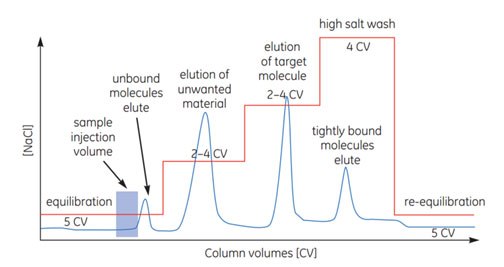
Figure A11.4. Step elution. Blue line = absorbance; red line = conductivity (salt concentration).
Hydrophobic Interaction Chromatography (HIC)
HIC media separate proteins with differences in hydrophobicity. The technique is well-suited for the capture or intermediate steps in a purification protocol. Separation is based on the reversible interaction between a protein and the hydrophobic surface of a chromatography medium. This interaction is enhanced by high ionic strength buffer, which makes HIC an excellent “next step” after precipitation with ammonium sulfate or elution in high salt during IEX. Samples in high ionic strength solution (e.g., 1.5 M ammonium sulfate) bind as they are loaded onto a column. Conditions are then altered so that the bound substances are eluted differentially.
Elution is usually performed by decreases in salt concentration (Figure A11.5). Changes are made stepwise or with a continuous decreasing salt gradient. Most commonly, samples are eluted with a decreasing gradient of ammonium sulfate. Target proteins are concentrated during binding and collected in a purified and concentrated form. Other elution procedures include reducing eluent polarity (ethylene glycol gradient up to 50%), adding chaotropic species (urea, Gua HCl), or detergents, changing pH or temperature.

Figure A11.5. Typical HIC gradient elution. Blue line = absorbance; red line = conductivity (salt concentration).
Method development (in priority order)
- The hydrophobic behavior of a protein is difficult to predict, and binding conditions must be studied carefully. Use HiTrap® HIC Selection Kit or RESOURCE HIC Test Kit to select the chromatography medium that gives optimal binding and elution over the required range of salt concentration. For proteins with unknown hydrophobic properties begin with a starting buffer containing, for example, 1 M to 1.5 M ammonium sulfate. Knowledge of the solubility of protein in the binding buffer is important because high concentrations of, for example, ammonium sulfate may precipitate proteins.
- Select a gradient that gives acceptable resolution. As a starting point, a linear gradient from 0 to 100% B of 10 to 20 columns volumes is recommended.
- Select the highest flow rate that maintains resolution and minimizes separation time. Check recommended flow rates for the specific medium and column.
- If samples bind strongly to a medium, separation conditions such as pH, temperature, chaotropic ions, or organic solvents may have caused conformational changes and should be altered. Conformational changes are specific to each protein. Use screening procedures to investigate the effects of these agents. Alternatively, change to a less hydrophobic chromatography medium.
To reduce separation times and buffer consumption, transfer to a step elution after method optimization, as shown in Figure A11.6.
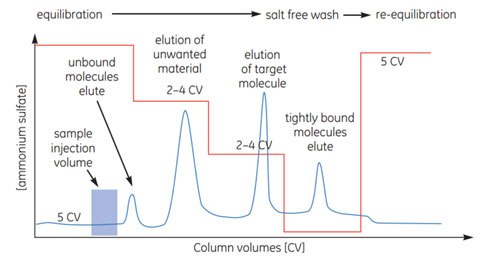
Figure A11.6. Step elution. Blue line = absorbance; red line = conductivity (salt concentration).
Size Exclusion Chromatography (SEC)
SEC media separate proteins with differences in molecular size and shape. The technique is well-suited for the final polishing steps in purification when sample volumes have been reduced (sample volume significantly influences speed and resolution in SEC). Samples are eluted isocratically (single buffer, no gradient, Figure A11.7). Buffer conditions can be varied to suit the sample type or the requirements for further purification, analysis, or storage, because buffer composition usually does not have major effects on resolution. Proteins are collected in purified form in the chosen buffer.
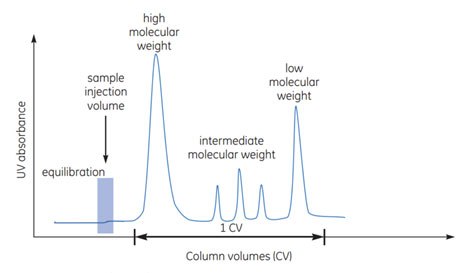
Figure A11.7. Typical SEC elution.
Reversed Phase Chromatography (RPC)
RPC media separate proteins and peptides with differing hydrophobicity based on their reversible interaction with the hydrophobic surface of a chromatographic medium. Proteins bind as they are loaded onto a column. Conditions are then altered so that the bound substances are eluted differentially. Due to the nature of the reversed phase matrices, binding is usually very strong. Binding may be modulated by the use of organic solvents and other additives (ion pairing agents). Elution is usually performed by increases in organic solvent concentration, most commonly acetonitrile. Samples that are concentrated during the binding and separation process are collected in a purified, concentrated form. The key stages in a separation are shown in Figure A11.8.

Figure A11.8. Typical RPC gradient elution. Blue line = absorbance; red line = % elution buffer.
RPC is often used in the final polishing of oligonucleotides and peptides and is well-suited for analytical separations, such as peptide mapping.
RPC is generally not recommended for protein purification if recovery of activity and return to a correct tertiary structure are required, because many proteins are denatured in the presence of organic solvents. Exceptions exist.
Method development
- Perform a screening and select chromatography medium from the results.
- Select optimal gradient to give acceptable resolution. As a starting point, a linear gradient from 0 to 100% B of 10 to 20 columns volumes is recommended.
- Select highest flow rate that maintains resolution and minimizes separation time.
- For large-scale purification, transfer to a step elution.
- Proteins that bind strongly to a chromatography medium are more easily eluted by changing to a less hydrophobic chromatography medium.
Materials
如要继续阅读,请登录或创建帐户。
暂无帐户?